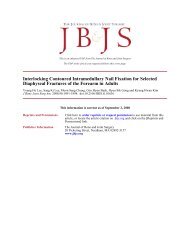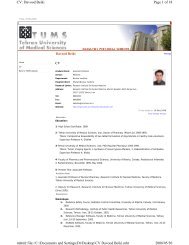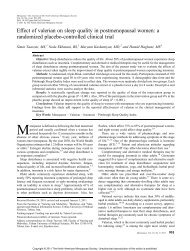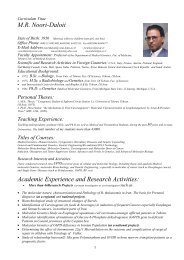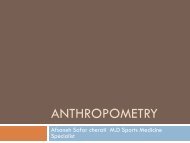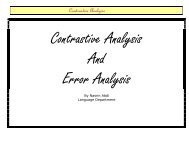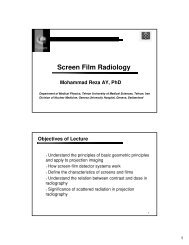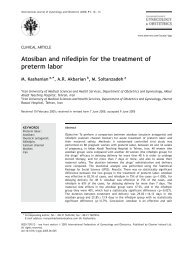Thermal Injury with Contemporary Cast-Application Techniques and ...
Thermal Injury with Contemporary Cast-Application Techniques and ...
Thermal Injury with Contemporary Cast-Application Techniques and ...
Create successful ePaper yourself
Turn your PDF publications into a flip-book with our unique Google optimized e-Paper software.
THE JOURNAL OF BONE & JOINT SURGERY · JBJS.ORG<br />
VOLUME 89-A · NUMBER 11 · NOVEMBER 2007<br />
portant as there is a risk of thermal injury when a fracture is<br />
splinted postoperatively. All too often, a splint is folded over<br />
when it has been cut to an inappropriate length, but this essentially<br />
doubles its thickness in a small area <strong>and</strong> thus increases<br />
the local exothermic reaction. Our recommendation<br />
is to trim excess plaster <strong>and</strong> resist the temptation to fold over<br />
the ends.<br />
We have offered potential interventions for reducing<br />
thermal risk, such as placing ice packs between the limb <strong>and</strong><br />
the pillow. Safer ways to avoid the risk of thermal injury in this<br />
setting would be to hold the limb or allow it to hang free during<br />
the curing process. The use of isopropyl alcohol to decrease<br />
the temperature of a curing cast has been reported<br />
anecdotally 17 . Our attempts to use it in this way revealed that,<br />
while the external temperature of the cast may go down, the<br />
internal temperature is minimally affected. In fact, the clinician<br />
may be fooled into thinking that the interior of the cast is<br />
cool because he or she can feel the external surface of the cast<br />
cooling (Fig. 7).<br />
In conclusion, the data on plaster material that were derived<br />
<strong>with</strong> the current model support previous authors’ findings,<br />
in particular that application of thicker plaster casts <strong>with</strong><br />
use of higher dip-water temperatures <strong>and</strong> placement of the<br />
limb on a pillow may lead to temperatures high enough to<br />
cause thermal injury. In addition, we were able to determine<br />
the temperature at various locations on the limb under the<br />
cast. This information is important so that clinicians realize<br />
that, while the temperature at one location of the cast may feel<br />
safe, the temperature elsewhere (i.e., in contact <strong>with</strong> the pil-<br />
1. Kaplan SS. Burns following application of plaster splint dressings. Report of<br />
two cases. J Bone Joint Surg Am. 1981;63:670-2.<br />
2. Lavalette R, Pope MH, Dickstein H. Setting temperatures of plaster casts.<br />
The influence of technical variables. J Bone Joint Surg Am. 1982;64:907-11.<br />
3. Gannaway JK, Hunter JR. <strong>Thermal</strong> effects of casting materials. Clin Orthop<br />
Relat Res. 1983;181:191-5.<br />
4. Goto M, Ogata K. Experimental study on thermal burns caused by plaster<br />
b<strong>and</strong>age. Nippon Seikeigeka Gakkai Zasshi. 1986;60:671-80.<br />
5. Pope MH, Callahan G, Lavalette R. Setting temperatures of synthetic casts.<br />
J Bone Joint Surg Am. 1985;67:262-4.<br />
6. Despa F, Orgill DP, Neuwalder J, Lee RC. The relative thermal stability of tissue<br />
macromolecules <strong>and</strong> cellular structure in burn injury. Burns. 2005;31:568-77.<br />
7. Henriques FC Jr, Moritz AR. Studies of thermal injury. I. The conduction of heat<br />
to <strong>and</strong> through skin <strong>and</strong> the temperatures attained therein. A theoretical <strong>and</strong> an<br />
experimental investigation. Am J Pathol. 1947;23:531-49.<br />
8. Moritz AR, Henriques FC Jr. Studies in thermal injury. II. The relative importance<br />
of time <strong>and</strong> surface temperature in the causation of cutaneous burns. Am J<br />
Pathol. 1947;23:695-720.<br />
9. Suzuki T, Hirayama T, Aihara K, Hirohata Y. Experimental studies of moderate<br />
2377<br />
References<br />
T HERMAL INJURY WITH CONTEMPORARY CAST-APPLICATION<br />
TECHNIQUES AND METHODS TO CIRCUMVENT MORBIDITY<br />
low) may not be. We also showed that overwrapping a curing<br />
plaster cast <strong>with</strong> fiberglass significantly increases its internal<br />
temperature. Allowing time for the plaster to cure completely<br />
before it is overwrapped <strong>with</strong> fiberglass should eliminate this<br />
problem.<br />
Appendix<br />
Three additional figures, including a plot of skin surface<br />
<strong>and</strong> external temperatures of a twelve-ply cast applied to<br />
the arm of an investigator, a comparison of skin (human) <strong>and</strong><br />
surface (model) temperatures after application of a twelve-ply<br />
cast (37°C), <strong>and</strong> a graph of representative plots of temperatures<br />
causing thermal injury (reference lines) are available <strong>with</strong> the<br />
electronic versions of this article, on our web site at jbjs.org<br />
(go to the article citation <strong>and</strong> click on “Supplementary Material”)<br />
<strong>and</strong> on our quarterly CD-ROM (call our subscription<br />
department, at 781-449-9780, to order the CD-ROM). <br />
NOTE: The authors thank the University of Wisconsin School of Biomedical Engineering students<br />
Stacey Hoebel, Kristin LaFortune, Katie Mantz, <strong>and</strong> Liz Thottakara for their help in the<br />
development <strong>and</strong> design of the experimental limbs used in this study.<br />
Matthew A. Halanski, MD<br />
Amy D. Halanski, MD<br />
Ashish Oza, BS<br />
Ray V<strong>and</strong>erby, PhD<br />
Alej<strong>and</strong>ro Munoz, PhD<br />
Kenneth J. Noonan, MD<br />
Department of Orthopaedics <strong>and</strong> Rehabilitation, University of Wisconsin,<br />
K4/732 Clinical Science Center, 600 Highl<strong>and</strong> Avenue, Madison, WI<br />
53792. E-mail address for K.J. Noonan: noonan@orthorehab.wisc.edu<br />
temperature burns. Burns. 1991;17:443-51.<br />
10. Henriques FC Jr. Studies of thermal injury. V. The predictability <strong>and</strong> the significance<br />
of thermally induced rate processes leading to irreversible epidermal injury.<br />
Arch Pathol. 1947;43:489-502.<br />
11. Xu Y, Qian R. Analysis of thermal injury process based on enzyme deactivation<br />
mechanisms. J Biomech Eng. 1995;117:462-5.<br />
12. Williamson C, Scholtz JR. Time-temperature relationships in thermal blister<br />
formation. J Invest Dermatol. 1949;12:41-7.<br />
13. LaMotte RH, Torebjörk HE, Robinson CJ, Thalhammer JG. Time-intensity profiles<br />
of cutaneous pain in normal <strong>and</strong> hyperalgesic skin: a comparison <strong>with</strong> C-fiber<br />
nociceptor activities in monkey <strong>and</strong> human. J Neurophysiol. 1984;51:1434-50.<br />
14. Subramanian B, Chato JC. Safe touch temperatures for hot plates. J Biomech<br />
Eng. 1998;120:727-36.<br />
15. Diller KR. Adapting adult scald safety st<strong>and</strong>ards to children. J Burn Care Res.<br />
2006;27:314-24.<br />
16. Becker DW. Danger of burns from fresh plaster splints surrounded by too<br />
much cotton. Plast Reconstr Surg. 1978;62:436-7.<br />
17. Wuest T. Use of alcohol to decrease temperature of a hot plaster. Personal<br />
communication, 1993.



